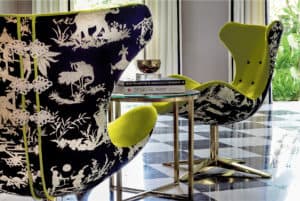Why Beauty Matters in Design: The Neuroscience Behind Aesthetics and Well-Being
At a recent panel discussion during SidFest for Singapore Design Week, I was asked a thought-provoking question:
“How has the concept of sustainability evolved in interior design, especially when working with clients who prioritize aesthetics over eco-friendly design?”
The question hinted at a common assumption that sustainability should take precedence over aesthetics, but I believe this assumption overlooks something fundamental. Beauty is often relegated to being secondary in design conversations, particularly when discussing sustainability. However, beauty is far more than just an add-on—it plays a central role in human experience and well-being.
The Historical Importance of Beauty
The value of beauty has been deeply embedded in human culture for millennia. Plato, one of the greatest philosophers in history, identified truth, goodness, and beauty as the three universal human values. Andrea Palladio, the father of modern architecture, insisted that a good building must have three essential qualities: form, function, and beauty. These figures understood that beauty is not a luxury—it is fundamental to the human experience.
For centuries, humans have built temples, museums, and monuments to honour beauty, demonstrating its integral role in society. It is only in the past century, with the rise of modernism and functionalism, that beauty began to be viewed as frivolous, secondary to more “practical” aspects like form and function. But the truth is, we are hard-wired to respond to beauty, and modern science is now catching up to what ancient wisdom has always known.
The Neuroscience of Beauty
Today, we have a wealth of research in neuroscience showing how beauty affects the brain. When we experience something beautiful, whether it’s a painting, a well-designed space, or a natural landscape, the pleasure centres of the brain light up. This triggers the release of neurotransmitters like dopamine and serotonin, which are responsible for feelings of happiness and well-being.
Studies using brain imaging have shown that viewing beautiful art or architecture can lower stress levels and increase feelings of joy. Stress hormones like cortisol decrease, while feel-good chemicals are released, enhancing both mood and cognitive function. Simply put, beauty makes us feel good, and feeling good leads to better health.
Beauty in Design is Health-Supporting
Beauty is not a frivolous luxury—it’s essential for human well-being.
By designing beautiful spaces, we can actively reduce stress, elevate moods, and even bolster physical health. Neuroscientific research has made it clear that environments rich in aesthetic appeal support not just emotional well-being but also cognitive and physical health.
Conclusion: Reimagining Sustainability
The evolution of sustainability in interior design must embrace both environmental impact and human health. We can no longer afford to treat beauty as a secondary consideration in the design process. As neuroscience reveals more about the link between aesthetics and well-being, it becomes clear that beauty is a critical component of truly sustainable design.
After all, what is the point of creating environmentally friendly spaces if they do not support the well-being of the people who live in them?













